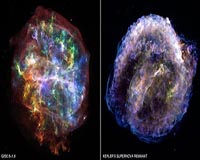 |
Paris (AFP) June 23, 2010 A planet named after ancient Egypt's Lord of the Dead is a place where human beings would be simultaneously boiled, poisoned and ripped apart by superstorms, astronomers reported on Wednesday. The distant world, orbiting a bright star in the constellation of Pegasus 150 light years from Earth, is known officially as HD 209458b, but has been nicknamed Osiris, the god of the Egyptian underworld. The label is especially fitting, given insights into the planet's climate system reported in the science journal Nature. Osiris races around its yellow, Sun-like star at a distance of around seven million kilometres (4.37 million miles) -- less than a twentieth of the distance between Earth and the Sun -- which means its "year" is just three and a half days. On one side its surface is heated to a scorching 1,100 degrees Celsius (1,800 degrees Fahrenheit), although the other side is far cooler. The planet's atmosphere is laced with poisonous carbon monoxide and prey to storm winds that blow from 5,000 to 10,000 kph (3,100-6,200 mph), says the paper. "HD 209458b is definitely not a place for the faint-hearted," quipped Ignas Snellen of Leiden Observatory, the Netherlands, who led a team of astronomers in the probe of the planet. Snellen's team observed Osiris for five hours last August, using the European Southern Observatory's Very Large Telescope (VLT) in the desert of Chile. The mission was to get a snapshot of the planet's atmosphere, using the VLT's infrared spectrograph, as the far-off world swung between its host star and Earth. For three precious hours, the planet's transit in front of its sun caused telltale changes in starlight received by the Earth-bound telescope. These tiny alterations were then transcribed as signatures of atmospheric physics and chemistry. A total of 462 exoplanets -- worlds in solar systems other than our own -- have been logged since the first was detected in 1995. None, though, is even remotely similar to our own planet, which is rocky and has water existing in liquid form. HD 209458b is one of the most-studied exoplanets. It has previously been measured at 60 percent the mass of Jupiter, the gas giant that is the biggest planet of our own star system. But it is far hotter, given its searing proximity to its own sun. The very precise measurements of carbon monoxide shows that the gas flows at extraordinary speed from the hot side to the cool side of the planet. "On Earth, big temperature differences inevitably lead to fierce winds and, as our new measurements reveal, the situation is no different on HD 209458b," said team member Simon Albrecht.
Share This Article With Planet Earth
Related Links Lands Beyond Beyond - extra solar planets - news and science Life Beyond Earth
 Kepler Data On Potential Extrasolar Planets Released
Kepler Data On Potential Extrasolar Planets ReleasedMoffett Field CA (SPX) Jun 16, 2010 NASA's Kepler Mission has released 43 days of science data on more than 156,000 stars. These stars are being monitored for subtle brightness changes as part of an ongoing search for Earth-like planets outside of our solar system. Astronomers will use the new data to determine if orbiting planets are responsible for brightness variations in several hundred stars. These stars make up a full ... read more |
|
| The content herein, unless otherwise known to be public domain, are Copyright 1995-2010 - SpaceDaily. AFP and UPI Wire Stories are copyright Agence France-Presse and United Press International. ESA Portal Reports are copyright European Space Agency. All NASA sourced material is public domain. Additional copyrights may apply in whole or part to other bona fide parties. Advertising does not imply endorsement,agreement or approval of any opinions, statements or information provided by SpaceDaily on any Web page published or hosted by SpaceDaily. Privacy Statement |